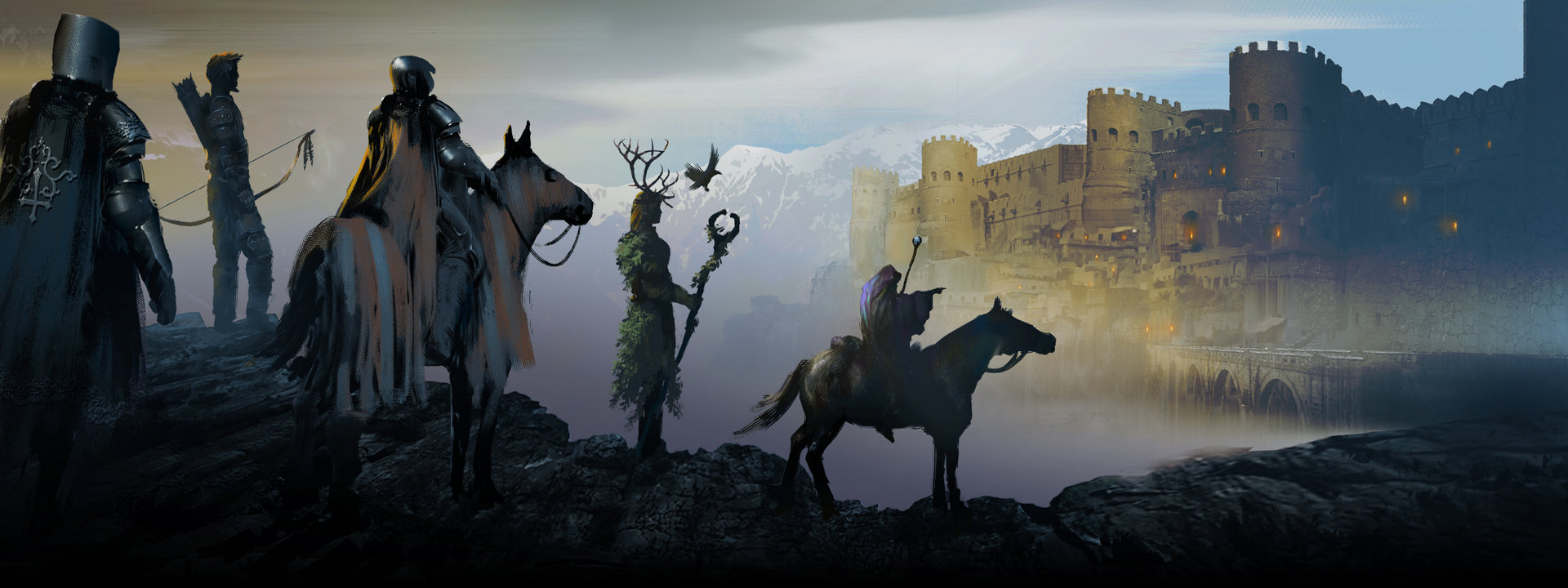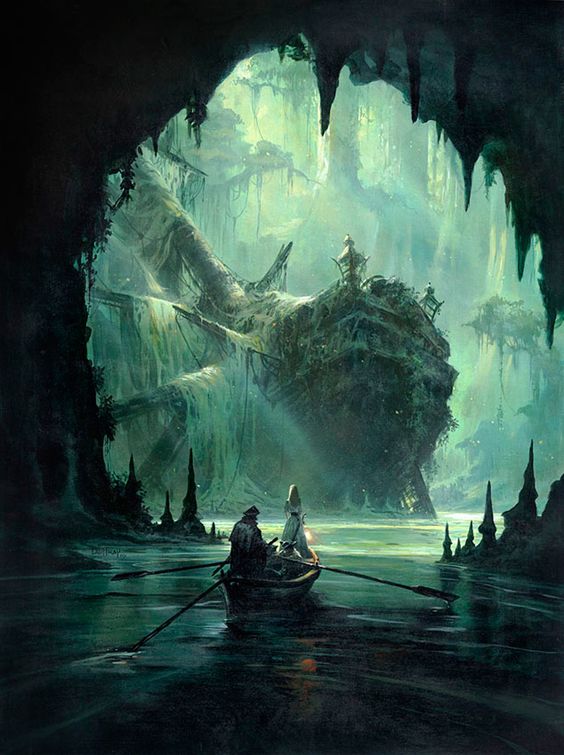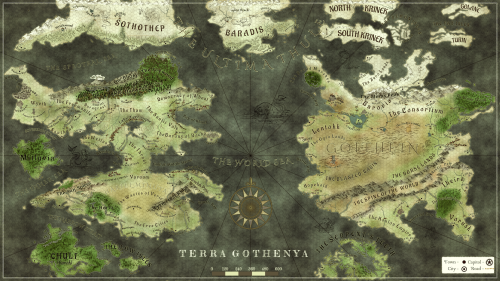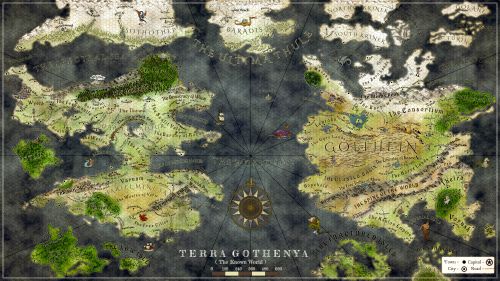The Known World
"Being a treatise on the global geography of Gothenya, including distances and dimensions of the great land masses."
The Known World...
Gothenya (sometimes referred to Gothen, for short) is our world. It is comprised of several large land masses, continents, mostly settled, a few wild. Gothens, another word for the denizens of the world. A Gothen is any native, be it man, elf, dwarf, halfling, etc.
To the West sits Hariel, the largest continent... actually two conjoined continents, in the world. The northern continent, larger and more populated, is Hariel Majour. Its sister continent, smaller, with more untamed lands, is referred to as Hariel Minuta. The two land masses are conjoined by The Throat, a narrow bridge, merely two hundred miles across at its widest point.
To the East, across the World Sea, lies the “newer” continent of Golthien, so named (with regards to Gothenya as a whole) to establish its dominance over all others.
The world is dominated by these three great land masses. The only known super continents (though the world has predominantly been mapped). There are many smaller land masses, mostly islands and archipelagos made from continents, destroyed long ago. Examples include the Demon Isles, in the frozen wastes north of Golthien. There’s also the micro-continent (more like a giant island) of Kreeluk (also known as Chult), southwest of Hariel Minuta.
The primary uncharted lands are north of both Hariel Majour and Golthien. A large belt of broken, frozen islands commonly referred to under the group name, Ultima Thule. These inhospitable lands are accessed from Hariel via the dreaded Spectral Sea, to the north of the continent. MOUNT CELENE and THE SUNDERING
In the northernmost lands of Hariel Majour (detailed below), stands the tallest mountain at the foot of a range of ice-capped peaks known as The Blight. This craggy monolith, a full thousand feet taller than its next tallest sister rock, is referred to by many names (Godshome, The High Seat of the Ancients), but most commonly Celene.
Similar to Mount Olympus, it is believed by those with a theological bent that Celene is (was) the home of the Gods. Both physically and spiritually. It is said to have fallen from the heavens ages ago (nobody knows when, yet it is recorded, by the learned sages called The Custodians, that Celene became “spiritually active” somewhere around forty thousand years ago). The landfall of Celene caused a tectonic upheaval, forming the very Blight itself. Whether by accident or design is the source of much speculation, and at one point, holy war. For thousands of years, disciples of all faiths made the long and treacherous pilgrimage to the mountain to prove their devotion or to seek divine (or magical) knowledge.
It is also said that Celene was once the greatest repository of magical energy ever to have existed. In fact, it was THE source of all magic in all Gothenya. As such, the pilgrimage was made not just by the holy, but by mages, sorcerers and warlocks of all orders and patrons.
The influx of so many representatives of both magic and the church, along with all the curious non-practitioners, created something of a cottage industry in the otherwise hostile, barren North. Suddenly, many towns, villages, and even a fortified city (Narfell) popped up to feed, house, and generally exploit the various visitors to the region.
The garrison city of Narfell was founded by Holy Knights (Paladins) of the Wyetheyne (so named for the sovereign line of Wyeth) “state religion” in order to protect holy travelers as they made the final trek to the base of Celene. For surrounding the mountain along its southern edge is the mangled, evil Dull Wood forest. During the Sundering of Celene, Narfell was employed as a bastion against the influx of goblin hordes forced from their lands during the Sundering.
DIMENSIONS OF THE PRIMARY CONTINENTS (East/West x North/South):
Hariel Major: 1,900 miles "wide" or across (longitude) x 950 miles "tall" (latitude) = 1,805,000 square miles
Hariel Minuta: 1,700 miles "wide" or across (longitude) x 900 miles "tall" (latitude) = 1,530,000 square miles
Golthein: 2,100 miles "wide" or across (longitude) x 3,000 miles "tall" (latitude) = 6,300,000 square miles
Ultima Thule (includes land bridge spanning subcontinents): 3,250 miles across (longitude) x 950 miles "tall" (latitude) = 3,087,500 square miles
DISTANCES FROM BRAMBLE:
All distances rounded up for approximation. Distances taken from "Detail Map" of Gothenya
Bramble to Angleport: 1,200 miles
Bramble to Narfell: 400 miles
Bramble to Cornelia (Barony of Rocha): 900 miles
Bramble to Celene (through Dullwood): 320 miles
Bramblle to Neishmehil (through Feywood): 600 miles
Bramble to Last Harvest: 270 miles
Bramble to Vale's End: 180 miles
Bramble to Sacrament: 650 miles
Bramble to Progress: 540 miles
Bramble to Varuumae Corona: 780 miles
* Travel by horse assumes approximately 60 miles/day (or two hex/day on the continent map scale).
Travel by foot assumes approximately 30 miles/day (or 1 hex/day on the continent map scale).
Travel pace assumes journey via the main roads (standard terrain). Rough terrain may reduce the travel speed by 1/2 or as much as 1/3, depending upon the terrain type.
*
Geography
MOUNT CELENE and THE SUNDERING
In the northernmost lands of Hariel Majour (detailed below), stands the tallest mountain at the foot of a range of ice-capped peaks known as The Blight. This craggy monolith, a full thousand feet taller than its next tallest sister rock, is referred to by many names (Godshome, The High Seat of the Ancients), but most commonly Celene.
Similar to Mount Olympus, it is believed by those with a theological bent that Celene is (was) the home of the Gods. Both physically and spiritually. It is said to have fallen from the heavens ages ago (nobody knows when, yet it is recorded, by the learned sages called The Custodians, that Celene became “spiritually active” somewhere around forty thousand years ago). The landfall of Celene caused a tectonic upheaval, forming the very Blight itself. Whether by accident or design is the source of much speculation, and at one point, holy war. For thousands of years, disciples of all faiths made the long and treacherous pilgrimage to the mountain to prove their devotion or to seek divine (or magical) knowledge.
It is also said that Celene was once the greatest repository of magical energy ever to have existed. In fact, it was THE source of all magic in all Gothenya. As such, the pilgrimage was made not just by the holy, but by mages, sorcerers and warlocks of all orders and patrons.
The influx of so many representatives of both magic and the church, along with all the curious non-practitioners, created something of a cottage industry in the otherwise hostile, barren North. Suddenly, many towns, villages, and even a fortified city (Narfell) popped up to feed, house, and generally exploit the various visitors to the region.
The garrison city of Narfell was founded by Holy Knights (Paladins) of the Wyetheyne (so named for the sovereign line of Wyeth) “state religion” in order to protect holy travelers as they made the final trek to the base of Celene. For surrounding the mountain along its southern edge is the mangled, evil Dull Wood forest. During the Sundering of Celene, Narfell was employed as a bastion against the influx of goblin hordes forced from their lands during the Sundering.
THE SUNDERING
Somewhere around two thousands years ago, when magic was far more common in Hariel Majour, a council of mages concluded that Celene’s magical repository was far greater than originally suspected. This notion was not dispelled by The Custodians. And as such, a great fellowship of “blasphemous” magicians (including the Grand Master who would eventually become the first ruler of Varuum) set out to “crack” the mountain wide. To unleash the magic they believed to be greedily stockpiled within. This ran in direct contradiction to virtually every civilized religion (except that of the Lentokki God Kings), and for the first and only time in recorded history, those of even opposing faiths banded together to fight a holy war against the plundering mages.
The war, later known as The Sundering, lasted for over one hundred years. Many of the greatest war clerics and blood magicians fell, with certain lines, orders, and devotions essentially wiped from the earth. Towards the closing of the war, it seemed that those of faith were set to win. Their enemies became desperate. The end came quick and unexpectedly, with a last great attack on the mountain itself. The most powerful and immoral of the Blood Mages used the life-force of captured high priests to channel an eldritch blast that ripped an enormous rent in the side of Celene. And from its newly formed maw sprang a might host of Goblinkind, more than have ever been seen organized before or since. But that wasn’t the worst of it, as a sea of raw entropy, the untamed Wild Magic, rushed forth, forming a mile-wide “moat” around Celene, always swirling against the laws of nature, it is known as The Churn.
The Blood Mages attempted to tame the Wild Magic. They were quick to learn the hubris behind this fatal mistake. An uncontrolled storm of the elements (fire, water, wind of rotating extremes of temperature, even flying boulders) pelted the region, felling even the mightiest trees at the northern edge of the Dull Wood. It is said that a great City of the Gods, could briefly be seen within the jagged rip in Celene’s side. The city, shaken by the elemental storm, collapsed under its own weight. As the structure of Celene remained intact, it’s interior instantly became an inaccessible ruin.
Some think the Gods died that day. Others, feeling the loss of their personal connection to their respective deities (yet still able to feel their presence), feared the entire pantheon had fallen into a coma of sorts. Some describe their spiritual communications to resemble those of bizarre dreams. Prayers were still answered, but not in any logical or ordered form. Thus, clerics of all devotions must be extremely careful when they commune with their deities.
In response to the Sundering, the persecution of all magic wielding peoples began in earnest. Before it could reach a genocidal level, once again mages, sorcerers and warlocks of all orders banded together to make a southern exodus, eventually forming the kingdom of Varuum and its neighboring freeholds. The magical death pogroms, though a thing of the past, left a lasting bias in Hariel Majour (particularly in the North). Gothens of a magical bent are wise to show a level of caution when displaying their abilities, as prejudice still abides.
As for the lake of Wild Magic, it has mostly dried up. But not before corrupting and distorting a vast array of creatures living in the Dull Wood. Even the denizens of the Blight itself have been “touched” by its mutating energies. The Dwarves of the Blight pushed deeper and deeper beneath the rock, out of fear. Fear of both the twisted creatures that represent the legacy of Celene, and the far more existential dread of having their bloodlines corrupted forever (not unlike the many mutant dragons that live in the highest reaches of The Blight).
Maps
-
Terra Gothenya
Map of the world, circa 1442 A.W. -
Most detailed Gothenya Map thus far...
Includes previously unknown locations, including several new islands and more cities in the east of Golthien. -
GOTHENYA (Complete)
The most up to date version of the world map.
Alternative Name(s)
Terra Gothenya
Type
Planet
Location under
Included Locations
Contested By
Characters in Location
Related Myths
Remove these ads. Join the Worldbuilders Guild










Comments